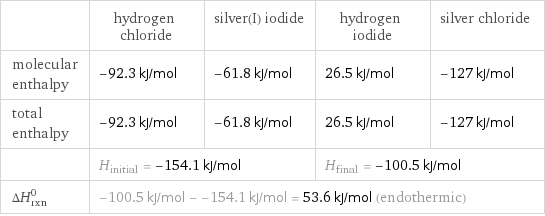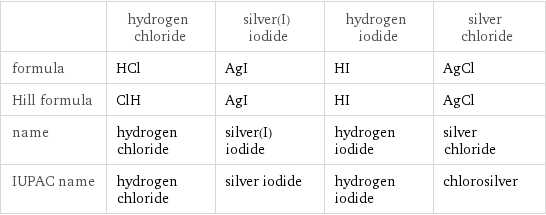Input interpretation

HCl (hydrogen chloride) + AgI (silver(I) iodide) ⟶ HI (hydrogen iodide) + AgCl (silver chloride)
Balanced equation

Balance the chemical equation algebraically: HCl + AgI ⟶ HI + AgCl Add stoichiometric coefficients, c_i, to the reactants and products: c_1 HCl + c_2 AgI ⟶ c_3 HI + c_4 AgCl Set the number of atoms in the reactants equal to the number of atoms in the products for Cl, H, Ag and I: Cl: | c_1 = c_4 H: | c_1 = c_3 Ag: | c_2 = c_4 I: | c_2 = c_3 Since the coefficients are relative quantities and underdetermined, choose a coefficient to set arbitrarily. To keep the coefficients small, the arbitrary value is ordinarily one. For instance, set c_1 = 1 and solve the system of equations for the remaining coefficients: c_1 = 1 c_2 = 1 c_3 = 1 c_4 = 1 Substitute the coefficients into the chemical reaction to obtain the balanced equation: Answer: | | HCl + AgI ⟶ HI + AgCl
Structures

+ ⟶ +
Names

hydrogen chloride + silver(I) iodide ⟶ hydrogen iodide + silver chloride
Reaction thermodynamics
Enthalpy

| hydrogen chloride | silver(I) iodide | hydrogen iodide | silver chloride molecular enthalpy | -92.3 kJ/mol | -61.8 kJ/mol | 26.5 kJ/mol | -127 kJ/mol total enthalpy | -92.3 kJ/mol | -61.8 kJ/mol | 26.5 kJ/mol | -127 kJ/mol | H_initial = -154.1 kJ/mol | | H_final = -100.5 kJ/mol | ΔH_rxn^0 | -100.5 kJ/mol - -154.1 kJ/mol = 53.6 kJ/mol (endothermic) | | |
Gibbs free energy

| hydrogen chloride | silver(I) iodide | hydrogen iodide | silver chloride molecular free energy | -95.3 kJ/mol | -66.2 kJ/mol | 1.7 kJ/mol | -109.8 kJ/mol total free energy | -95.3 kJ/mol | -66.2 kJ/mol | 1.7 kJ/mol | -109.8 kJ/mol | G_initial = -161.5 kJ/mol | | G_final = -108.1 kJ/mol | ΔG_rxn^0 | -108.1 kJ/mol - -161.5 kJ/mol = 53.4 kJ/mol (endergonic) | | |
Equilibrium constant
![Construct the equilibrium constant, K, expression for: HCl + AgI ⟶ HI + AgCl Plan: • Balance the chemical equation. • Determine the stoichiometric numbers. • Assemble the activity expression for each chemical species. • Use the activity expressions to build the equilibrium constant expression. Write the balanced chemical equation: HCl + AgI ⟶ HI + AgCl Assign stoichiometric numbers, ν_i, using the stoichiometric coefficients, c_i, from the balanced chemical equation in the following manner: ν_i = -c_i for reactants and ν_i = c_i for products: chemical species | c_i | ν_i HCl | 1 | -1 AgI | 1 | -1 HI | 1 | 1 AgCl | 1 | 1 Assemble the activity expressions accounting for the state of matter and ν_i: chemical species | c_i | ν_i | activity expression HCl | 1 | -1 | ([HCl])^(-1) AgI | 1 | -1 | ([AgI])^(-1) HI | 1 | 1 | [HI] AgCl | 1 | 1 | [AgCl] The equilibrium constant symbol in the concentration basis is: K_c Mulitply the activity expressions to arrive at the K_c expression: Answer: | | K_c = ([HCl])^(-1) ([AgI])^(-1) [HI] [AgCl] = ([HI] [AgCl])/([HCl] [AgI])](../image_source/18d1abb8cd1b5657c9ecec2cbd780957.png)
Construct the equilibrium constant, K, expression for: HCl + AgI ⟶ HI + AgCl Plan: • Balance the chemical equation. • Determine the stoichiometric numbers. • Assemble the activity expression for each chemical species. • Use the activity expressions to build the equilibrium constant expression. Write the balanced chemical equation: HCl + AgI ⟶ HI + AgCl Assign stoichiometric numbers, ν_i, using the stoichiometric coefficients, c_i, from the balanced chemical equation in the following manner: ν_i = -c_i for reactants and ν_i = c_i for products: chemical species | c_i | ν_i HCl | 1 | -1 AgI | 1 | -1 HI | 1 | 1 AgCl | 1 | 1 Assemble the activity expressions accounting for the state of matter and ν_i: chemical species | c_i | ν_i | activity expression HCl | 1 | -1 | ([HCl])^(-1) AgI | 1 | -1 | ([AgI])^(-1) HI | 1 | 1 | [HI] AgCl | 1 | 1 | [AgCl] The equilibrium constant symbol in the concentration basis is: K_c Mulitply the activity expressions to arrive at the K_c expression: Answer: | | K_c = ([HCl])^(-1) ([AgI])^(-1) [HI] [AgCl] = ([HI] [AgCl])/([HCl] [AgI])
Rate of reaction
![Construct the rate of reaction expression for: HCl + AgI ⟶ HI + AgCl Plan: • Balance the chemical equation. • Determine the stoichiometric numbers. • Assemble the rate term for each chemical species. • Write the rate of reaction expression. Write the balanced chemical equation: HCl + AgI ⟶ HI + AgCl Assign stoichiometric numbers, ν_i, using the stoichiometric coefficients, c_i, from the balanced chemical equation in the following manner: ν_i = -c_i for reactants and ν_i = c_i for products: chemical species | c_i | ν_i HCl | 1 | -1 AgI | 1 | -1 HI | 1 | 1 AgCl | 1 | 1 The rate term for each chemical species, B_i, is 1/ν_i(Δ[B_i])/(Δt) where [B_i] is the amount concentration and t is time: chemical species | c_i | ν_i | rate term HCl | 1 | -1 | -(Δ[HCl])/(Δt) AgI | 1 | -1 | -(Δ[AgI])/(Δt) HI | 1 | 1 | (Δ[HI])/(Δt) AgCl | 1 | 1 | (Δ[AgCl])/(Δt) (for infinitesimal rate of change, replace Δ with d) Set the rate terms equal to each other to arrive at the rate expression: Answer: | | rate = -(Δ[HCl])/(Δt) = -(Δ[AgI])/(Δt) = (Δ[HI])/(Δt) = (Δ[AgCl])/(Δt) (assuming constant volume and no accumulation of intermediates or side products)](../image_source/a725b09233114cdd918566172aff0aa9.png)
Construct the rate of reaction expression for: HCl + AgI ⟶ HI + AgCl Plan: • Balance the chemical equation. • Determine the stoichiometric numbers. • Assemble the rate term for each chemical species. • Write the rate of reaction expression. Write the balanced chemical equation: HCl + AgI ⟶ HI + AgCl Assign stoichiometric numbers, ν_i, using the stoichiometric coefficients, c_i, from the balanced chemical equation in the following manner: ν_i = -c_i for reactants and ν_i = c_i for products: chemical species | c_i | ν_i HCl | 1 | -1 AgI | 1 | -1 HI | 1 | 1 AgCl | 1 | 1 The rate term for each chemical species, B_i, is 1/ν_i(Δ[B_i])/(Δt) where [B_i] is the amount concentration and t is time: chemical species | c_i | ν_i | rate term HCl | 1 | -1 | -(Δ[HCl])/(Δt) AgI | 1 | -1 | -(Δ[AgI])/(Δt) HI | 1 | 1 | (Δ[HI])/(Δt) AgCl | 1 | 1 | (Δ[AgCl])/(Δt) (for infinitesimal rate of change, replace Δ with d) Set the rate terms equal to each other to arrive at the rate expression: Answer: | | rate = -(Δ[HCl])/(Δt) = -(Δ[AgI])/(Δt) = (Δ[HI])/(Δt) = (Δ[AgCl])/(Δt) (assuming constant volume and no accumulation of intermediates or side products)
Chemical names and formulas

| hydrogen chloride | silver(I) iodide | hydrogen iodide | silver chloride formula | HCl | AgI | HI | AgCl Hill formula | ClH | AgI | HI | AgCl name | hydrogen chloride | silver(I) iodide | hydrogen iodide | silver chloride IUPAC name | hydrogen chloride | silver iodide | hydrogen iodide | chlorosilver
Substance properties

| hydrogen chloride | silver(I) iodide | hydrogen iodide | silver chloride molar mass | 36.46 g/mol | 234.7727 g/mol | 127.912 g/mol | 143.32 g/mol phase | gas (at STP) | solid (at STP) | gas (at STP) | solid (at STP) melting point | -114.17 °C | 557 °C | -50.76 °C | 455 °C boiling point | -85 °C | 1506 °C | -35.55 °C | 1554 °C density | 0.00149 g/cm^3 (at 25 °C) | 5.68 g/cm^3 | 0.005228 g/cm^3 (at 25 °C) | 5.56 g/cm^3 solubility in water | miscible | slightly soluble | very soluble | dynamic viscosity | | | 0.001321 Pa s (at -39 °C) |
Units
